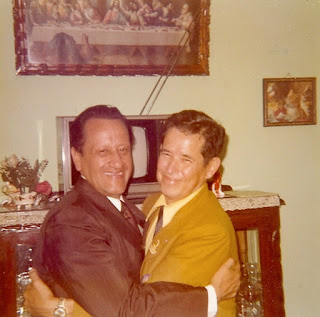Gilbert Cayetano Huesca (1915 - 2009)
Joan Joyce (Schiavon) Huesca (1928 - 1987)
 |
| My parents, Gilbert and Joan Huesca, on their first trip together - on business! Saint Louis, Missouri, October 30, 1954. |
My parents delayed their honeymoon in Mexico for a couple of months. I don't know why, but my guess would be that among other things, my father wanted my mother to see Mexico at Christmastime, when the country is at its most magical.
Instead, their first trip was to Saint Louis, Missouri, to the Screen Process Printing Association's Convention, from October 30 - November 2, 1954. My mother was now a co-owner with my father of Lakeshore Printing, the business he had started, and she wanted to learn as much as she could to help make the business successful.
While a convention of silk screen printers may not sound like a romantic occasion for a newlywed couple, the photograph above would suggest that they did not mind much, as long as they could be together.
In late November, my parents flew south to Mexico City, where my father proudly introduced his beautiful bride to his mother, Catalina (Perrotin) Huesca, his grandmother, Maria (Amaro) Perrotin, and his brothers and sisters and their families.
.
 |
| My parents, Gilbert and Joan Huesca, with my grandmother, Catalina (Perrotin) Huesca, at the Los Panchos Nightclub (owned by the famous Trio Los Panchos), Mexico City, December 1954 |
They all went to my grandmother's apartment on Carpio Street, where she prepared a special dinner in her tiny kitchen to welcome my parents. Long after everyone had gone home, my parents and my grandmother sat up late into the night, talking up a storm. When many years later my mother would tell us the story of that first night and the days that followed, she would marvel at how she and Abuelita could spend hours alone talking, my mother speaking English and my grandmother speaking Spanish, and yet they seemed to understand each other perfectly.
 |
| Catrin (Huesca) and Ricardo Díaz, about 1950 |
As the night came to a close, my mother asked my father how to thank her new brother-in-law for his kindness.
"Muchas gracias," my father instructed her, "tú eres muy amable."
By the time she found Uncle Ricardo, however, the original translation had evolved to, "Muchas gracias, Hermano (Brother). Tú eres un muy gran mueble."
 |
| My ever-smiling uncle, Ricardo Díaz, and my father, Gilbert Huesca, at my grandmother's home on Carpio Street, Mexico City, 1972. |
My mother was mortified by the thought that she had insulted her host. But Uncle Ricardo loved it. He began laughing heartily and hugged my mother. He and my Aunt Catrín were charmed by her earnestness and unabashed effort to communicate in her broken Spanish. Although my father and his younger sister had always been close, that evening would mark the beginning of a lifelong close fraternal love between the two couples and eventually, their daughters.
My parents' stay in the Federal District came to a close after Christmas. My father had originally proposed a honeymoon in Acapulco, but they never made it there until many years later. It didn't seem to matter, though. Rather, they went to the 300-year-old colonial town of Tequisquiapan, Querétaro (a two hour drive north of Mexico City), for some much-anticipated time alone.
The name of the town, pronounced "Teh-keys-key-ah-pahn," seemed to melt in their mouths whenever they would mention it in the years that followed. They said it with reverence and ease and lightness, as if it held a wonderful memory that forever would be known only by them.
 |
| My mother, Joan Huesca, on the balcony of my parents' hotel, Tequisquiapan, Querétaro, Mexico, December 1954. |
My father was thrilled with his family's warm reception of my mother as one of them, and he delighted in showing her his favorite places and teaching her the language and customs of his native country. For my mother's part, she could hardly believe the surge of love she felt: for my father, for his family - now her family, too; and for Mexico - the magnificent and welcoming birthplace of her beloved husband who she called her "Ranchero," or rancher.
She would fall in love with the Spanish language, too. Though she never mastered it the way she had hoped, she always made herself understood by using the language of true communication: sincerity, humility, and love. Truth be told, I think those who knew her loved her more for that than if she had been a master linguist.
She would fall in love with the Spanish language, too. Though she never mastered it the way she had hoped, she always made herself understood by using the language of true communication: sincerity, humility, and love. Truth be told, I think those who knew her loved her more for that than if she had been a master linguist.
Copyright © 2012 Linda Huesca Tully








Linda - I wanted you to know that I nominated your blog for a "Liebster Blog" award. Here is the link: http://www.abbieandeveline.com/2013/01/11/a-dearest-honor/
ReplyDeleteThanks so much for your kind nomination, Kathy! I am honored, especially as I am a fan of your own fascinating blog.
DeleteHave a happy New Year!